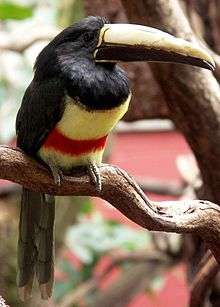Black-necked aracari
| Black-necked aracari | |
|---|---|
 | |
| Scientific classification | |
| Kingdom: | Animalia |
| Phylum: | Chordata |
| Class: | Aves |
| Order: | Piciformes |
| Family: | Ramphastidae |
| Genus: | Pteroglossus |
| Species: | P. aracari |
| Binomial name | |
| Pteroglossus aracari (Linnaeus, 1758) | |
| Subspecies | |
|
See text | |
| Synonyms | |
| |
The black-necked aracari (US: /ˌɑːrəˈsɑːri/ AHR-ə-SAHR-ee,[2] UK: /ˌɑːrəˈsɑːri/ ARR-ə-SAHR-ee or /ˌɑːrəˈkɑːri/ ARR-ə-KAHR-ee),[3] or black-necked araçari (Pteroglossus aracari), is a species of bird in the toucan family. It is found in Brazil, French Guiana, Guyana, Suriname, and Venezuela.
Taxonomy and systematics
The black-necked aracari was originally classified in the genus Ramphastos. Alternate names include beautiful araçari and Maximilian's aracari.
Subspecies
Three subspecies are recognized:[4]
- P. a. atricollis - (Statius Müller, PL, 1776): Originally described as a separate species. Found in eastern Venezuela, the Guianas and northern Brazil
- P. a. aracari - (Linnaeus, 1758): Found in north-eastern, eastern and south-eastern Brazil
- P. a. wiedii - Sturm, JHCF & Sturm, JW, 1847: Originally described as a separate species in the genus Pteroglossus. Found in south-eastern Brazil
Description
The black-necked aracari measures 35–45 cm (14–18 in) long and weighs 177-309 grams (6-10.9 oz.)[5] It is a typical but thickset aracari with a single red band across its otherwise yellow chest. Its upper mandible is pale yellow while the lower mandible is black.
Habitat
Its natural habitats are subtropical or tropical moist lowland forests and heavily degraded former forest.
References
- ↑ BirdLife International (2012). "Pteroglossus aracari". IUCN Red List of Threatened Species. Version 2013.2. International Union for Conservation of Nature. Retrieved 26 November 2013.
- ↑ "Aracari". Dictionary.com Unabridged. Random House, Inc.). Retrieved 2012-04-20.
- ↑ "Definition for aracari". Oxford Dictionaries Online. Archived from the original on 23 July 2012. Retrieved 2012-04-20.
- ↑ "IOC World Bird List 6.4". IOC World Bird List Datasets. doi:10.14344/ioc.ml.6.4.
- ↑ "Archived copy". Archived from the original on 19 August 2007. Retrieved 2007-08-19.
